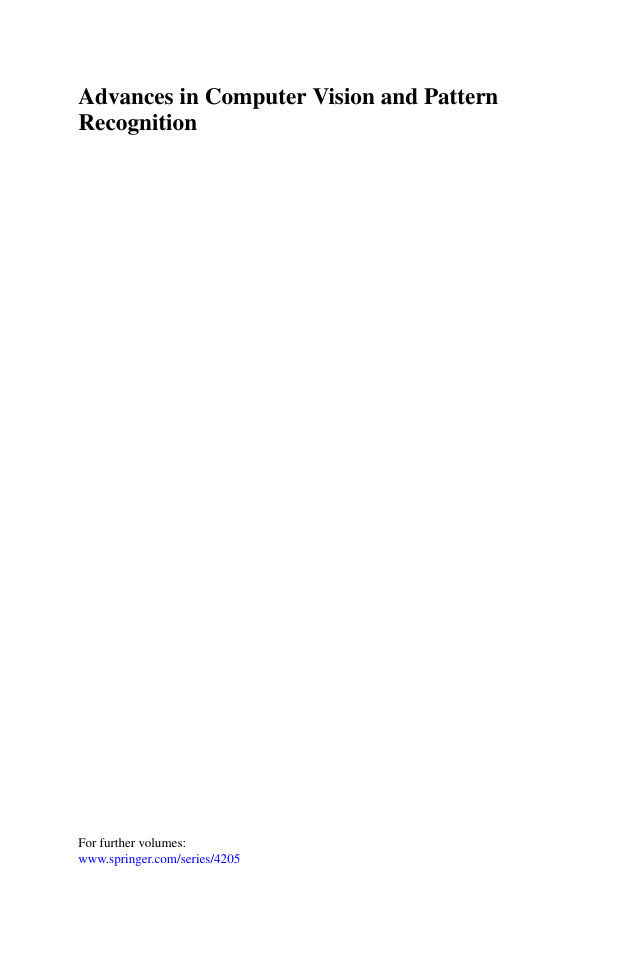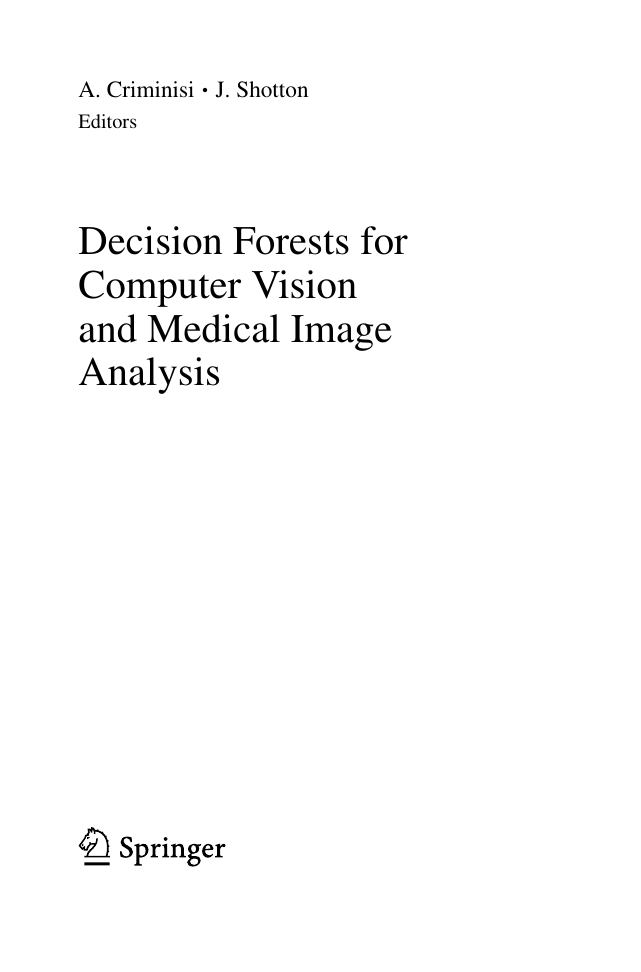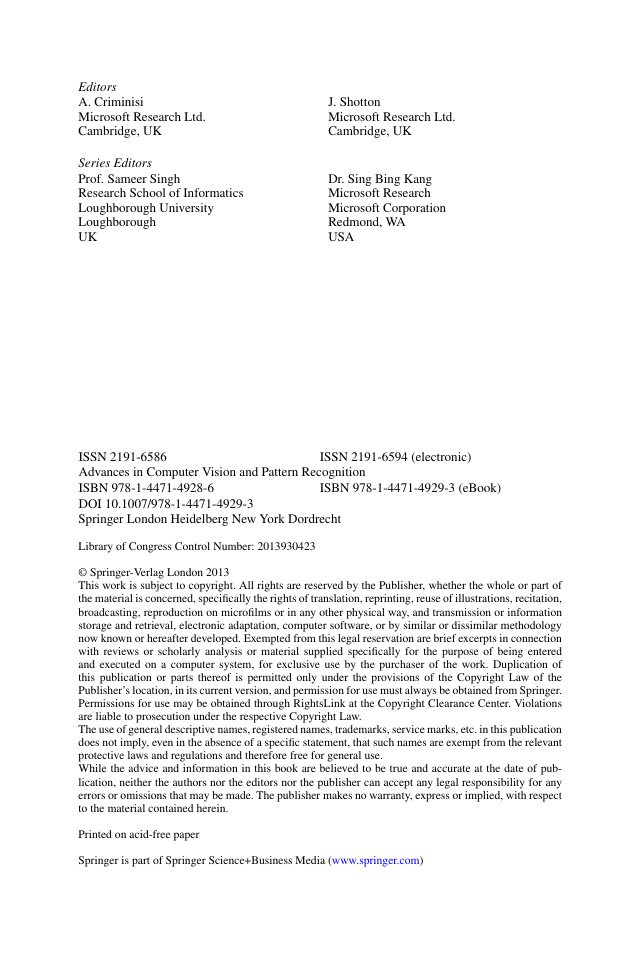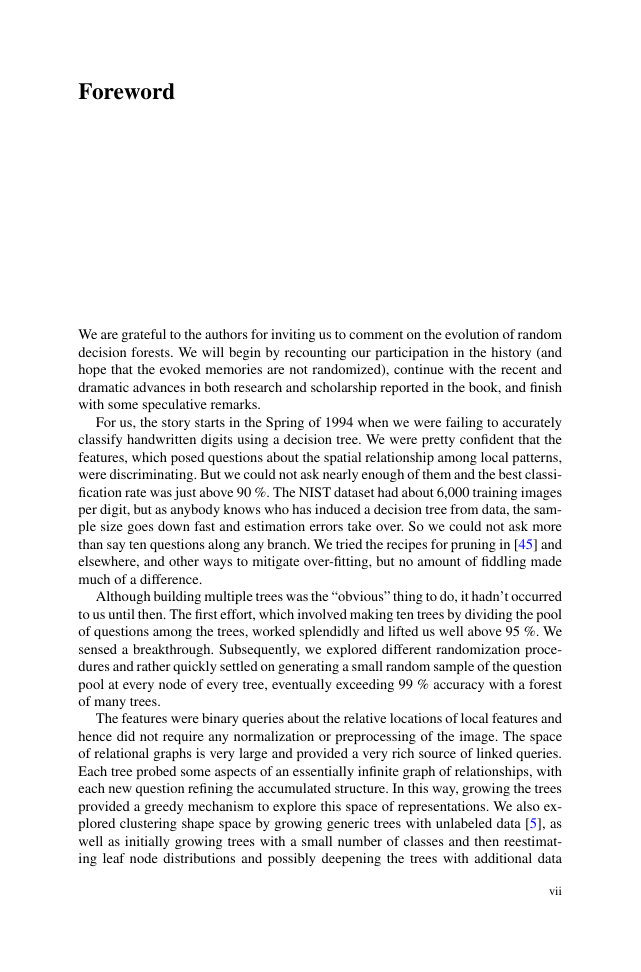Decision Forests for Computer Vision and Medical Image Analysis
Foreword
Preface
Acknowledgements
Contents
Contributors
Chapter 1: Overview and Scope
A Chronological Literature Review
Chapter 2: Notation and Terminology
2.1 Notation
2.2 Common Terms
Part I: The Decision Forest Model
Chapter 3: Introduction: The Abstract Forest Model
3.1 Decision Tree Basics
3.1.1 Tree Data Structure
3.1.2 Decision Tree
3.2 Mathematical Notation and Basic Definitions
3.2.1 Data Point and Features
3.2.2 Test Functions, Split Functions and Weak Learners
3.2.3 Training Points and Training Sets
3.3 Randomly Trained Decision Trees
3.3.1 Tree Testing (On-line Phase)
3.3.2 Tree Training (Off-line Phase)
Tree Structure
3.3.3 Weak Learner Models
Linear Data Separation
Non-linear Data Separation
3.3.4 Energy Models
Entropy and Information Gain
3.3.5 Leaf Prediction Models
3.3.6 The Randomness Model
3.3.6.1 Bagging
3.3.6.2 Randomized Node Optimization (RNO)
3.4 Combining Trees into a Forest Ensemble
3.4.1 Key Model Parameters
3.5 Summary
Chapter 4: Classification Forests
4.1 Classification Algorithms in the Literature
4.2 Specializing the Decision Forest Model for Classification
Problem Statement
4.2.1 The Training Objective Function
4.2.2 Class Re-balancing
4.2.3 Randomness
4.2.4 The Leaf and Ensemble Prediction Models
4.3 Effect of Model Parameters
4.3.1 The Effect of the Forest Size on Generalization
4.3.2 Multiple Classes and Training Noise
4.3.3 The Effect of the Tree Depth
4.3.4 The Effect of the Weak Learner
4.3.5 The Effect of Randomness
4.4 Maximum Margin Classification with Forests
4.4.1 The Effect of Randomness on Optimal Separation
4.4.2 Influence of the Weak Learner Model
4.4.3 Maximum Margin with Multiple Classes
4.4.4 The Effect of the Randomness Model
4.5 Summary
4.6 Exercises and Experiments
Chapter 5: Regression Forests
5.1 Non-linear Regression in the Literature
5.2 Specializing the Decision Forest Model for Regression
Problem Statement
What Are Regression Forests?
5.2.1 The Prediction Model
5.2.2 The Ensemble Model
5.2.3 Randomness Model
5.2.4 The Training Objective Function
5.2.5 The Weak Learner Model
5.3 Effect of Model Parameters
5.3.1 The Effect of the Forest Size
5.3.2 The Effect of the Tree Depth
5.3.3 Spatial Smoothness and Testing Uncertainty
5.4 Summary
5.5 Exercises and Experiments
Chapter 6: Density Forests
6.1 Density Estimation in the Literature
6.2 Specializing the Forest Model for Density Estimation
Problem Statement
What Are Density Forests?
6.2.1 The Training Objective Function
Discussion
6.2.2 The Prediction Model
The Partition Function
6.2.3 The Ensemble Model
6.2.4 Discussion
6.3 Effect of Model Parameters
6.3.1 The Effect of Tree Depth
6.3.2 The Effect of Forest Size
6.3.3 More Complex Examples
6.4 Comparison with Alternative Algorithms
6.4.1 Comparison with Non-parametric Estimators
6.4.2 Comparison with GMM EM
6.4.3 Comparing Computational Complexity
6.5 Sampling from the Generative Model
6.5.1 Efficiency
6.5.2 Results
6.6 Quantitative Analysis
6.7 Summary
6.8 Exercises and Experiments
Chapter 7: Manifold Forests
7.1 Manifold Learning and Dimensionality Reduction in the Literature
7.2 Specializing the Forest Model for Manifold Learning
Problem Statement
What Are Manifold Forests?
7.2.1 The Training Objective Function
7.2.2 The Predictor Model
7.2.3 The Affinity Model
7.2.4 The Ensemble Model
7.2.5 Estimating the Embedding Function
7.2.6 Mapping Previously Unseen Points
7.2.7 Properties and Advantages
7.2.7.1 Ensemble Clustering for Distance Estimation
An Illustrative Example
7.2.7.2 Choosing the Feature Space
7.2.7.3 Computational Efficiency
7.2.7.4 Estimating the Target Intrinsic Dimensionality
7.3 Experiments and the Effect of Model Parameters
7.3.1 The Effect of the Forest Size
7.3.2 Manifold Learning in Higher Dimensions
7.3.3 Discovering the Manifold Intrinsic Dimensionality
7.4 Summary
Chapter 8: Semi-supervised Classification Forests
8.1 Semi-supervised Learning in the Literature
8.2 Specializing the Decision Forest Model for Semi-supervised Classification
Problem Statement
What Are Semi-supervised Forests?
8.2.1 The Training Objective Function
8.3 Transduction Trees for Classifying Already Available Data
8.3.1 Transductive Ensemble
8.4 Induction from Transduction
8.4.1 Inductive Ensemble
8.4.2 Discussion
8.5 Examples, Comparisons and Effect of Model Parameters
8.5.1 The Effect of Additional Supervision, and Active Learning
8.5.2 Comparison with Transductive SVMs
8.5.3 Handling Multiple Classes
8.5.4 The Effect of Tree Depth
8.6 Summary
8.7 Exercises and Experiments
Part II: Applications in Computer Vision and Medical Image Analysis
Chapter 9: Keypoint Recognition Using Random Forests and Random Ferns
9.1 Introduction
9.2 Wide-Baseline Point Matching as a Classification Problem
9.3 Keypoint Recognition with Classification Forests
9.3.1 Random Classification Forests
9.3.2 Node Tests
9.3.3 Building the Trees
9.4 Keypoint Recognition with Random Ferns
9.4.1 Random Ferns
9.4.2 Training the Ferns
9.5 Comparing Random Forests, Random Ferns, and SIFT
9.5.1 Empirical Comparisons of Trees and Ferns
9.5.2 Empirical Comparisons Between SIFT and Ferns
9.6 Discussion
9.7 Application Example
9.8 Conclusion
Chapter 10: Extremely Randomized Trees and Random Subwindows for Image Classification, Annotation, and Retrieval
10.1 Introduction
10.2 Random Subwindow-Based Image Analysis
10.2.1 Training Stage
10.2.2 Prediction Stage
10.2.3 Discussion
10.2.3.1 Subwindows Extraction
10.2.3.2 Subwindows Transformation
10.2.3.3 Feature Extraction
10.3 Extremely Randomized Trees
10.3.1 Extremely and Totally Randomized Trees
10.3.2 Multiple Output Trees
10.3.3 Kernel View of Tree-Based Ensembles
10.4 Applications
10.4.1 Content-Based Image Retrieval
10.4.1.1 Method
10.4.1.2 Illustration
10.4.2 Image Classification
10.4.2.1 Method
10.4.2.2 Illustration
10.4.3 Interest Point Detection
10.4.3.1 Method
10.4.3.2 Illustration
10.4.4 Image Segmentation
10.4.4.1 Method
10.4.4.2 Illustration
10.5 Conclusions and Future Works
Chapter 11: Class-Specific Hough Forests for Object Detection
11.1 Introduction
11.2 Related Work
11.3 Building Hough Forests
11.3.1 Training Data and Leaf Information
11.3.2 Patch Appearance and Binary Tests
11.3.3 Tree Construction
11.4 Object Detection with Hough Forests
11.4.1 Handling Variable Scales and Aspect Ratios
11.4.2 Leaf Pruning
11.5 Experiments
11.5.1 UIUC Cars
11.5.2 TUD Pedestrians, INRIA Pedestrians, Weizmann Horses
11.5.3 Does Offset Supervision Matter?
11.6 Discussion
Chapter 12: Hough-Based Tracking of Deformable Objects
12.1 Introduction
12.2 Related Work
12.3 Online Hough Ferns
12.3.1 Random Ferns
12.3.2 Hough Voting
12.3.3 Incremental Leaf Node Statistics
12.3.4 Online Adaptation
12.3.5 Support
12.4 Closing the Tracking Loop
12.5 Experimental Evaluation
12.5.1 Bounding Box Dataset
12.5.2 Tracking Deformable Objects
12.5.3 Bounding Box vs. Segmentation-Based Tracking
12.5.4 Discussion and Implementation Details
12.6 Conclusion
Chapter 13: Efficient Human Pose Estimation from Single Depth Images
13.1 Introduction
13.2 Data
Body Part Classification Labels
Offset Joint Regression Labels
13.3 Method
13.3.1 Depth Image Features
13.3.2 Weak Learners
13.3.3 Leaf Node Prediction Models
Body Part Classification (bpc)
Offset Joint Regression (ojr)
13.3.4 Aggregating Predictions
13.3.5 Training
13.3.5.1 Tree Structure Training
Classification
Regression
Discussion
13.3.5.2 Leaf Node Prediction Models
13.4 Experiments
13.4.1 Test Data
13.4.2 Qualitative Results
13.4.3 Comparison Between bpc and ojr
13.4.4 Comparison to Ganapathi et al. [121]
13.5 Conclusions
Chapter 14: Anatomy Detection and Localization in 3D Medical Images
14.1 Introduction
Regression Approach
Comparison with Classification-Based Approaches
Comparison with Registration-Based Approaches
14.2 Organ Localization as Regression Task
14.2.1 Parametrization and Regression Formulation
14.3 Regression Forests for Organ Localization
14.3.1 Feature Responses for Application in CT and MR
Visual Features in CT
Visual Features in MR
14.3.2 Regression Forest Learning
Weak Learners
Objective Function
Stopping Criterion
Discussion
14.3.3 Regression Forest Prediction
Forest Testing
Organ Localization
Organ Detection
14.4 Results, Comparisons and Validation
14.4.1 Anatomy Localization in Computed Tomography Scans
The Labeled CT Database
Quantitative Evaluation
Computational Efficiency
Comparison with Affine, Atlas-Based Registration
Automatic Landmark Detection
14.4.2 Anatomy Localization in Magnetic Resonance Scans
The Labeled MR Database
Comparative Experiments
14.5 Conclusion
Chapter 15: Semantic Texton Forests for Image Categorization and Segmentation
15.1 Introduction
15.1.1 Related Work
15.2 Randomized Decision Forests
15.3 Semantic Texton Forests
15.3.1 Learning Invariances
15.3.2 Implementation Details
15.3.3 Bags of Semantic Textons
Implementation Details
15.4 Image Categorization
15.5 Semantic Segmentation
Appearance Context vs. Semantic Context
15.5.1 Image-Level Prior
15.6 Experiments
15.6.1 Learning the Semantic Texton Forest Vocabulary
15.6.2 Image Categorization
15.6.3 Semantic Segmentation
15.6.3.1 Experiments on the MSRC Dataset [341]
15.6.3.2 Experiments on the VOC 2007 Segmentation Dataset [99]
15.7 Conclusions
Chapter 16: Semi-supervised Video Segmentation Using Decision Forests
16.1 Introduction
16.2 Literature Review
16.2.1 Unsupervised Video Segmentation
16.2.2 Classification-Based Segmentation
Unstructured Classification
Structured Classification
16.2.3 Semi-supervised Video Segmentation
16.2.4 Work-Flow-Based Video Segmentation
16.3 Video Model for Semi-supervised Segmentation
16.3.1 Model Construction
16.3.2 Inference
16.3.2.1 From Patches to Pixel Posteriors
16.3.2.2 Forward and Backward Trees
16.3.2.3 Intra-frame Smoothing of Pixel Labels
16.3.3 Learning Pixel Unaries Using a Random Forest
16.4 Experiments and Results
16.5 Advantages and Drawbacks
16.6 Conclusions
Chapter 17: Classification Forests for Semantic Segmentation of Brain Lesions in Multi-channel MRI
17.1 Introduction
Why Classification Forests for Medical Image Segmentation?
17.2 Classification Forests for Segmentation of Brain Tumor Tissues
17.2.1 Context-Aware Voxel Classification
17.2.1.1 Estimating Initial Tissue Probabilities
17.2.1.2 Spatial Visual Features
17.2.2 Evaluation
17.2.2.1 Experiments
17.3 Classification Forests for Segmentation of MS Lesions
17.3.1 Data
17.3.2 Feature Types
17.3.3 Experiments
17.3.4 Discussion
17.3.4.1 Interpretation of Segmentation Results
17.3.4.2 Influence of Forest Parameters
17.3.4.3 Analysis of the Relevance of Feature Types and Channels
17.4 Conclusion
Chapter 18: Manifold Forests for Multi-modality Classification of Alzheimer's Disease
18.1 Introduction
18.2 Background: Biomarkers for Alzheimer's Disease
18.2.1 Cerebrospinal Fluid Measures of Neuropathology
18.2.2 Functional Imaging with Positron Emission Tomography
18.2.3 Structural Imaging with Magnetic Resonance Imaging
18.2.4 Risk Factors for Disease Development
18.3 Multi-modality Classification Framework
18.3.1 Manifold Forests for Multi-modality Classification
18.3.2 Implementation Details
18.4 Neuroimaging and Biological Data for Evaluation
18.4.1 Neuroimaging features
18.4.2 Biological features
18.5 Classification Experiments and Results
18.5.1 Single-Modality Classification Results
18.5.2 Single-Modality Similarity-Based Classification Results
18.5.3 Multi-modality Similarity-Based Classification Results
18.6 Conclusions
Chapter 19: Entanglement and Differentiable Information Gain Maximization
19.1 Introduction
19.2 Entangled Decision Forests
19.2.1 Entanglement Feature Design
19.2.1.1 Appearance Features
19.2.1.2 Semantic Context Entanglement Features
MAPClass Entanglement Features
TopNClasses Entanglement Features
NodeDescendant Entanglement Features
AncestorNodePair Entanglement Features
19.2.2 Guiding Feature Selection by Learned Proposal Distributions
19.2.3 Results
Qualitative Results
Quantitative Impact of Each Contribution
Efficiency Considerations
Inspecting the Chosen Features
19.3 Differentiable Information Gain Maximization
19.3.1 Formulating Differentiable Information Gain
Soft Label Decision Forests
19.3.2 Split Function Design and Gradient Ascent Optimization
Hyperplane Partition
Hyper-Ellipsoid Partition
19.3.3 Object Tracking via Information Gain Maximization
GainMax in Feature Space: Updating the Appearance Model
GainMax in Image Space: Tracking the Target
19.3.4 Results
19.3.4.1 Classification of Public Machine Learning Datasets
19.3.4.2 Object Tracking in Videos
19.4 Discussion and Conclusion
Chapter 20: Decision Tree Fields: An Efficient Non-parametric Random Field Model for Image Labeling
20.1 Introduction
20.2 Related Work
20.3 Model
20.3.1 Relation to Other Models
20.4 Learning Decision Tree Fields
20.4.1 Maximum Likelihood Learning
20.4.2 Pseudolikelihood
20.4.3 Learning the Tree Structure
20.4.4 Complexity of Training
20.4.5 Making Training Efficient
20.4.6 Inference
20.5 Experiments
20.5.1 Conditional Interactions: Toy Snake Dataset
20.5.2 Learning Calligraphy: Chinese Characters
20.5.3 Body-Part Detection
20.6 Conclusion
Part III: Implementation and Conclusion
Chapter 21: Efficient Implementation of Decision Forests
21.1 Introduction
21.1.1 Notation
21.2 Depth First and Breadth First Training
21.2.1 Depth First Training
21.2.2 Breadth First Training
21.2.3 Properties
21.3 Weak Learner Implementation
21.3.1 Computing Responses on the Fly
21.3.2 Multiple Candidate Thresholds per Feature
21.3.3 Efficient Threshold Selection
21.4 Data Structures
21.4.1 Tree Memory Organization
21.4.2 Split and Leaf Node Representation
21.5 Parallelization
21.5.1 Multi-core CPU Implementation
21.5.1.1 Parallel-For
21.5.1.2 Parallel Training
21.5.1.3 Parallel Inference
21.5.1.4 Multi-threading Considerations
21.5.2 GPU Implementation
21.5.3 Distributed Computing Implementation
21.6 Parameter Tuning
21.6.1 Maximum Tree Depth, D
21.6.2 Number of Trees in the Forest, T
21.6.3 Number of Candidate Weak Learners
21.6.4 Number of Candidate Response Thresholds per Feature
21.7 Tricks of the Trade
21.7.1 In-place Partitioning of Training Data
21.7.2 Retrospective Tuning of Maximum Tree Depth
21.7.3 Dealing with Unbalanced Datasets
21.7.4 Bagging and Leaf Predictors
21.7.5 Augmenting Your Training Set
21.7.6 Sampling Weak Learner Parameters
21.7.7 Reducing Correlation Between Trees in a Forest
21.8 Conclusion
Chapter 22: The Sherwood Software Library
22.1 Introduction
22.2 Getting Started
22.3 Architectural Overview
22.4 Performance Considerations
22.5 Application Illustration: Supervised Classification
22.5.1 Implementing Interfaces
22.5.2 Training the Forest
22.5.3 Serialization and Deserialization
22.5.4 Testing
22.6 Other Applications
Density Estimation
1D-1D Regression
Semi-supervised Classification
22.7 Summary
Chapter 23: Conclusions
23.1 Summary
23.2 Successes and Challenges
Success Stories
Remaining Challenges
23.3 Conclusion
Further Material
References
Index
















 2023年江西萍乡中考道德与法治真题及答案.doc
2023年江西萍乡中考道德与法治真题及答案.doc 2012年重庆南川中考生物真题及答案.doc
2012年重庆南川中考生物真题及答案.doc 2013年江西师范大学地理学综合及文艺理论基础考研真题.doc
2013年江西师范大学地理学综合及文艺理论基础考研真题.doc 2020年四川甘孜小升初语文真题及答案I卷.doc
2020年四川甘孜小升初语文真题及答案I卷.doc 2020年注册岩土工程师专业基础考试真题及答案.doc
2020年注册岩土工程师专业基础考试真题及答案.doc 2023-2024学年福建省厦门市九年级上学期数学月考试题及答案.doc
2023-2024学年福建省厦门市九年级上学期数学月考试题及答案.doc 2021-2022学年辽宁省沈阳市大东区九年级上学期语文期末试题及答案.doc
2021-2022学年辽宁省沈阳市大东区九年级上学期语文期末试题及答案.doc 2022-2023学年北京东城区初三第一学期物理期末试卷及答案.doc
2022-2023学年北京东城区初三第一学期物理期末试卷及答案.doc 2018上半年江西教师资格初中地理学科知识与教学能力真题及答案.doc
2018上半年江西教师资格初中地理学科知识与教学能力真题及答案.doc 2012年河北国家公务员申论考试真题及答案-省级.doc
2012年河北国家公务员申论考试真题及答案-省级.doc 2020-2021学年江苏省扬州市江都区邵樊片九年级上学期数学第一次质量检测试题及答案.doc
2020-2021学年江苏省扬州市江都区邵樊片九年级上学期数学第一次质量检测试题及答案.doc 2022下半年黑龙江教师资格证中学综合素质真题及答案.doc
2022下半年黑龙江教师资格证中学综合素质真题及答案.doc